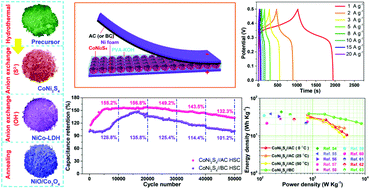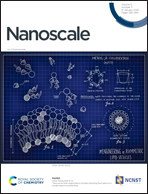Designed synthesis of nickel–cobalt-based electrode materials for high-performance solid-state hybrid supercapacitors†
Abstract
Supercapacitors with high security, excellent energy and power densities, and superior long-term cycling performance are becoming increasingly essential for flexible devices. Herein, this study has reported a novel method to synthesize CoNi2S4, which delivered a high specific capacitance of 1836.6 F g−1 at 1 A g−1, with a slight fluctuation in the testing temperature rising up to 50 °C (1855.2 F g−1) or decreasing to 0 °C (1587.6 F g−1). In addition, the corresponding solid-state CoNi2S4//AC HSC could achieve a high energy density of 35.8 W h kg−1 at a power density of 800.0 W kg−1, with nearly no change when tested at 0 °C and 50 °C, and possessed excellent long-term electrochemical cycling stability of 132.3% after 50 000 cycles; the solid-state hybrid supercapacitor using biomass-derived carbon (BC) as the negative electrode (CoNi2S4//BC HSC) could also deliver a high energy density of 38.9 W h kg−1 at a power density of 850.0 W kg−1 and the specific capacitance retention was 101.2% after cycling for 50 000 times. This work has provided a promising method to prepare high-performance electrode materials for solid-state hybrid supercapacitors with superior cycling stability and energy density.



 Please wait while we load your content...
Please wait while we load your content...